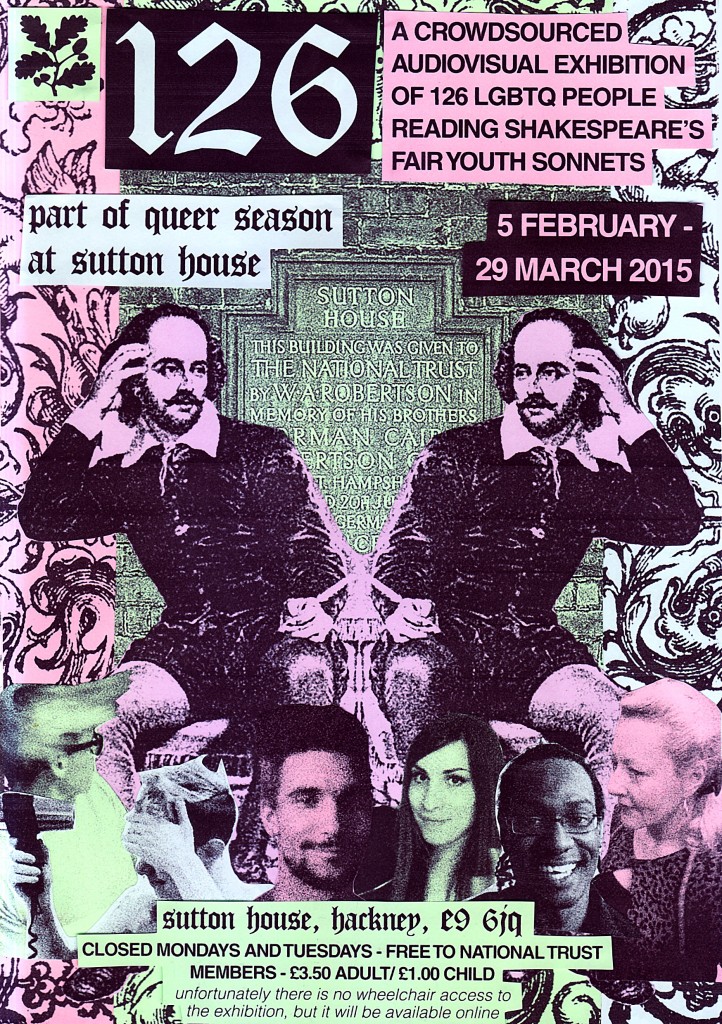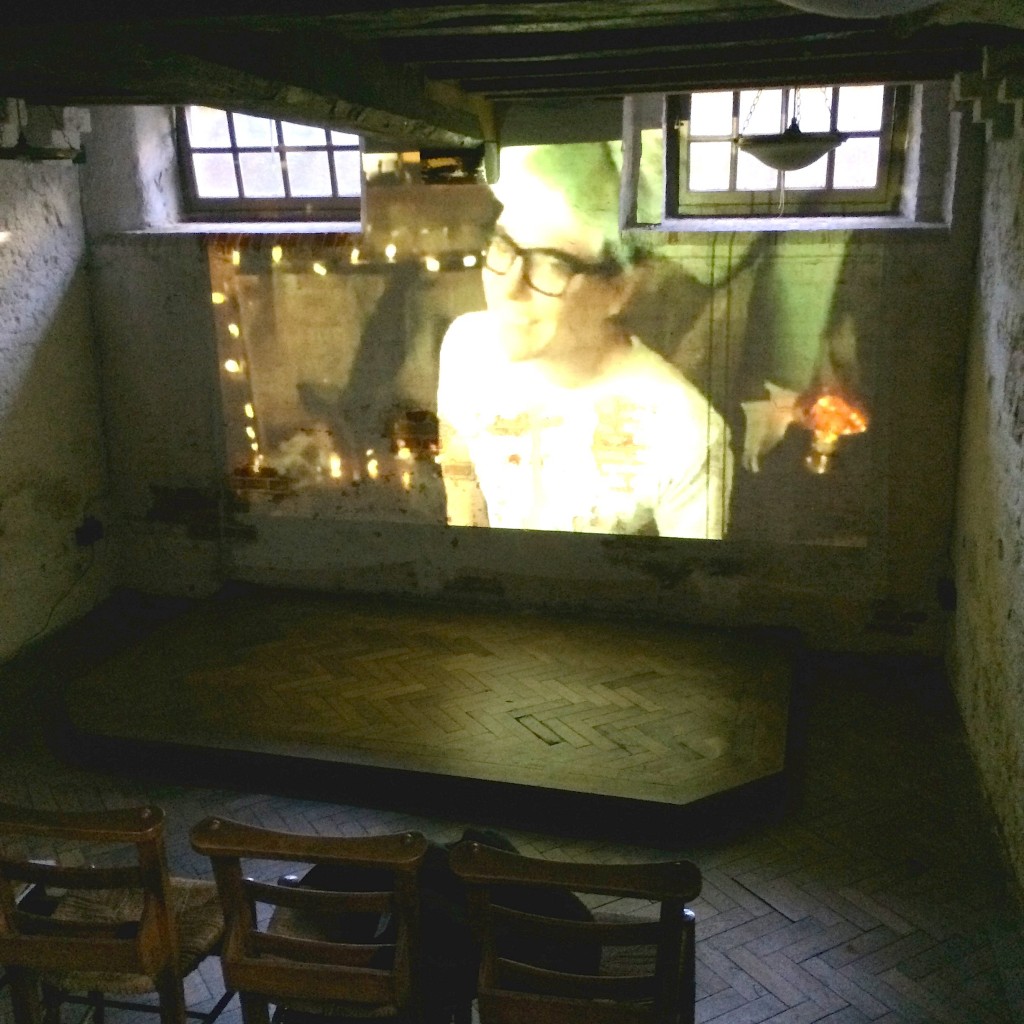Just a decade ago, the idea of an exhibition addressing LGBT themes in a National Trust house would likely have been dismissed. Today, however, the Trust is desperately trying to eschew its reputation as a stuffy and conservative organisation that, as writer George Monbiot notes, regurgitates a ‘sanitised, tea-towel history’. There have, in the last few years, been a number of initiatives that have begun to undo this reputation, including: the artist group ‘Unravelled’ and their work at Nymans House and Garden, former Tudor powerhouse The Vyne, and others; The National Trust London Project’s initiatives such as the Soho Stories App, a GPS sound tour ‘bringing 60 years of Bohemian Soho to life’; and the pop-up takeovers of the Big Brother House and studios in flat 130 of the brutalist former social housing block Balfron Tower.
My own research is based on the National Trust property Sutton House in Hackney. Built by statesman Ralph Sadleir in 1535, when Hackney was a quiet pastoral village escape from the bustle of London, Sutton House typifies a grand Tudor home. Sadleir left Sutton House in 1546 and sold it to merchant John Machell four years later, the first of many subsequent owners or occupiers who in turn painted their own distinct marks on what is now the oldest house in Hackney. I began volunteering at Sutton House in the summer of 2013, and after a few months suggested curating an exhibition to be held during LGBT History Month (February in the UK). The staff at Sutton House were keen to address LGBTQ audiences, as it would be a first for the house.

In a house that discordantly places Tudor spaces alongside a Victorian room, Squatters graffiti from the 80s, an art gallery, a tearoom and a gift shop, perhaps the most obvious mark is that of the National Trust, who acquired the house in the 1930s and opened it to the public once renovations were completed in the 1990s. Most other grand historic houses owned by the Trust can be found in rural settings and have footfalls of largely white, middle-class visitors. Sutton House’s urban setting, and the diverse community it serves, makes it one of the National Trust’s biggest anomalies. Sutton House also defies the mould for the National Trust by the scarcity of original objects, artworks and pieces of furniture on show in its rooms. It’s a blank canvas open to opportunity and interpretation.
Master-Mistress
My own contribution to the evolution of the National Trust began with last February’s exhibition ‘Master-Mistress’ which addressed the ambiguities in Shakespeare’s sonnets. The first 126 of Shakespeare’s sonnets are known as the Fair Youth sonnets and are widely thought to have been written to a man. In 1640, publisher John Benson notoriously changed all of the pronouns in the sonnets to suggest that the subject was always a woman, demonstrating a discomfort with the implied love–platonic or sexual–for another man. The exhibition aimed to address these grey areas.
‘Master-Mistress’ consisted of four of the Fair Youth sonnets playing on loop in some of Sutton House’s Tudor rooms. The sonnets were read by people who identify as LGBT or Q and the sounds were played from Mock-Tudor speakers made by artist Judith Brocklehurst. The discordant speakers aimed to queer time, by being positioned both in the past and the present. One visitor to the exhibition, however, thought it strange that an exhibition aimed at making queer identities visible included objects that blended in with their surroundings, and wondered if it was at the National Trust’s request that we had done this. This speaks volumes about how the National Trust is perceived, and feedback like this formed the basis of the exhibition’s evolution when I was invited to curate its follow up.
126
‘126’ takes the core idea of ‘Master-Mistress’ one step further to include queer readings of all 126 of the Fair Youth sonnets. This time, via social media, I launched an open call out for LGBTQ-identified people to record their own readings of a sonnet that I assigned to them, alongside a ten second video portrait or ‘moving selfie’. The result is an audiovisual experience in the chapel of Sutton House, which runs until the end of March.
As part of LGBT History Month 2014, I chaired a panel event called ‘Challenging histories’. Academics and queer heritage pioneers discussed the place of LGBTQ people and narratives in museums and heritage sites. This led the staff at Sutton House to eschew the confines of LGBT History Month in 2015, and instead host its first ever ‘Queer Season’, which runs for two months. For me, this was a great victory, as I feel an increasing discomfort with LGBT History Month, and the limiting quality of ‘History Months’ in general. Alongside ‘126’, the season features a showing throughout the house of works by artist Nick Fox, and an ‘anti-Valentine’s’ event held on the 14th hosted by Amy Grimehouse. This immersive cinema /arts club night celebrated trashy, camp, cult and transgressive film in locations across London and featured a screening of 90s queer cult classic The Craft. Sutton House’s bold series of events mark it as a pioneer among National Trust historic houses.

Particularly for a property like Sutton House, embedded in a diverse urban community, engagement is key. I was initially drawn to researching historic houses to understand how they have contributed to the invisibility of queer identities. As a queer person in a world that is still only tolerant of me, whenever I consume any form of culture I am always looking for some sign of myself and of a community. Sutton House now demonstrates how to create inclusive spaces that celebrate LGBTQ and other communities, offering a creative example of engagement that staff at other National Trust and historic sites will hopefully build upon. This remains a critical task because, as artist Matt Smith notes, the silencing of queer voices in heritage sites that were, at one time, domestic spaces is to suppress queerness in the only place where, historically, queer identities could be lived safely: Home.
 Sean Curran is a PhD candidate at UCL Institute of Education, where they research the invisibility of queer identities in historic houses, specifically National Trust houses. Sean is a National Trust volunteer, and a curator. They are on the steering committee for the annual London Metropolitan Archive LGBTQ History and Archives conference, and the HLF project Twilight People: stories of faith and gender beyond the binary. Sean blogs at towardsqueer and tweets @MeltingSwans.
Sean Curran is a PhD candidate at UCL Institute of Education, where they research the invisibility of queer identities in historic houses, specifically National Trust houses. Sean is a National Trust volunteer, and a curator. They are on the steering committee for the annual London Metropolitan Archive LGBTQ History and Archives conference, and the HLF project Twilight People: stories of faith and gender beyond the binary. Sean blogs at towardsqueer and tweets @MeltingSwans.

NOTCHES: (re)marks on the history of sexuality is licensed under a Creative Commons Attribution-NonCommercial-NoDerivatives 4.0 International License.
Based on a work at www.notchesblog.com.
For permission to publish any NOTCHES post in whole or in part please contact the editors at NotchesBlog@gmail.com




